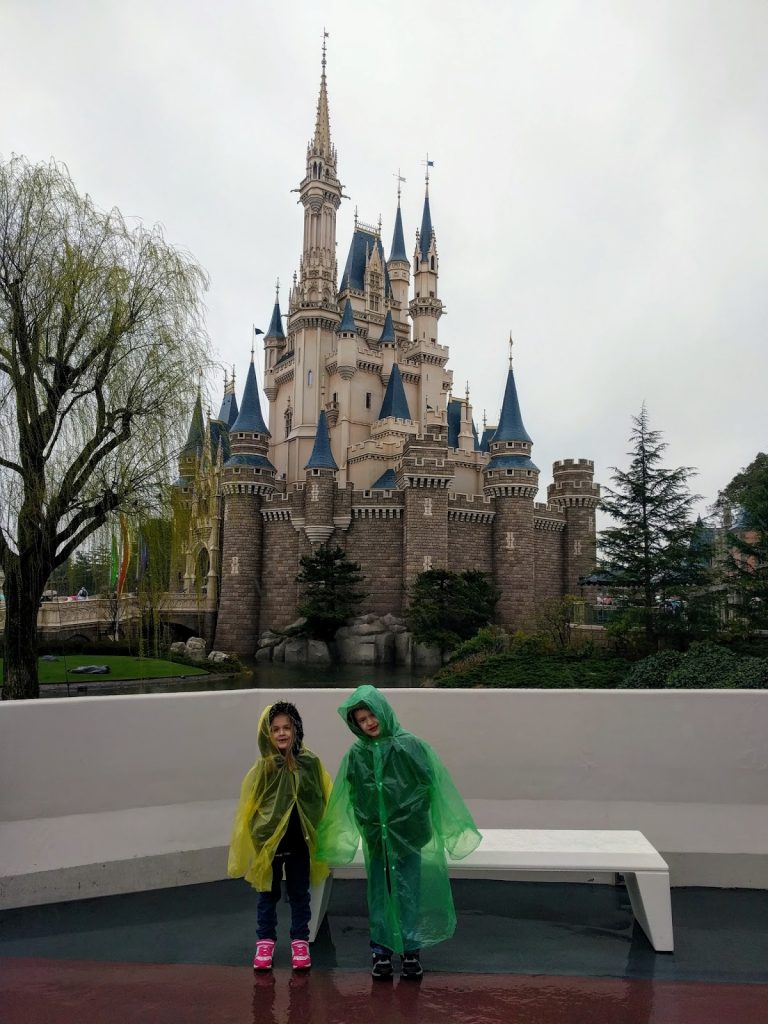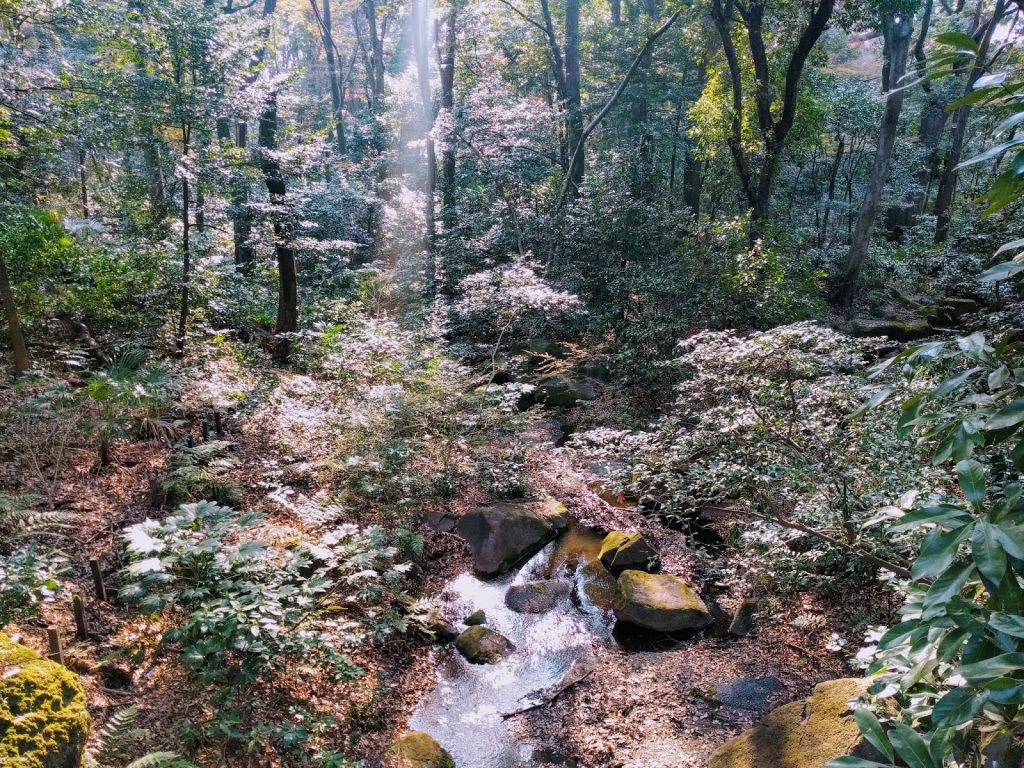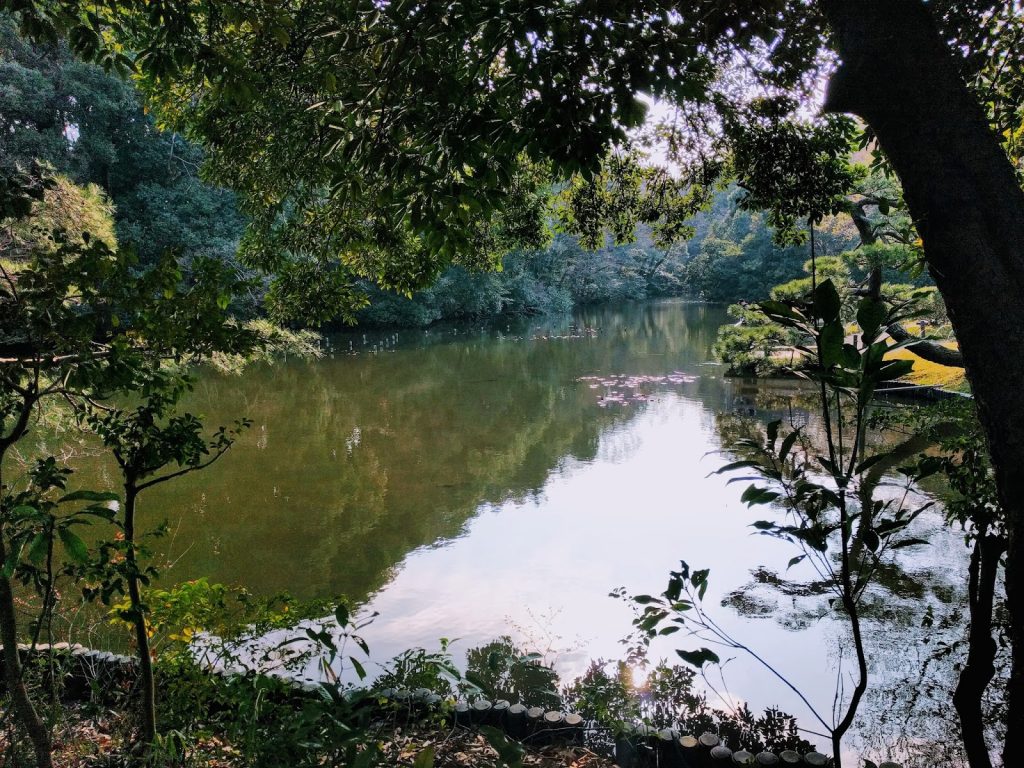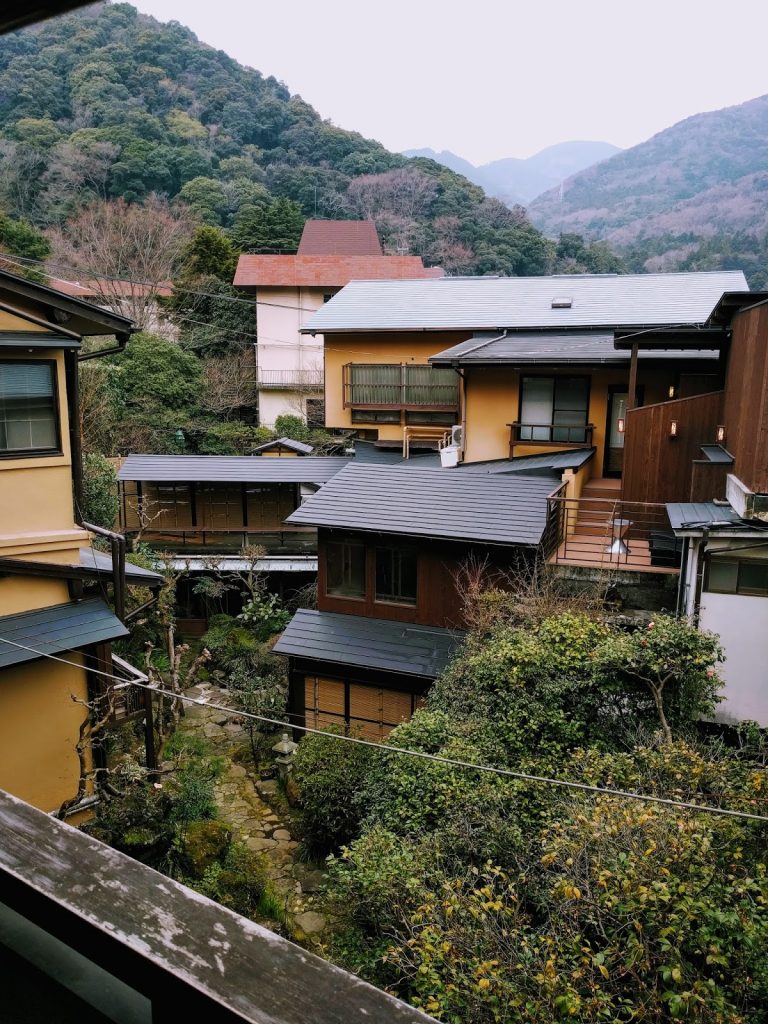We returned Sunday night from a trip to Japan for our first R&R. I had an ambitious schedule planned, and we got a lot done in one week. Unfortunately, things didn’t go quite as planned in all areas.
For starters, it was supposed to be 60° and the week of cherry blossoms, but a storm system came through at the last minute so half the week was 40° and rainy. I didn’t really pack for 40° and rainy – though we did grab our umbrellas and some ponchos as we were walking out the door – and I had no idea my tennis shoes were 50% sponge. The cherry blossoms, in their wisdom, were having none of it.
Side note: What the heck is up with the whole poncho thing? I’ve never used ponchos before, and I have to say: what a dumb invention. Raincoat? Yes, please. Umbrella? Handy if you have a backpack to protect. Poncho? No. Just… no. They’re cheap and tear easily, the size is all wrong, you have to take them off anytime you go indoors so the wetness on the outside spreads everywhere making you wet the next time you try to put it on, they blow around in the wind, and you can’t even use your pockets to protect your hands from the cold. They’re just stupid. Did you see those pictures of Bush Jr. fighting with his poncho at inauguration? That was me through half of Disneyland. I will never trust you again, ponchos. NEVER.

We arrived in Tokyo Saturday evening and checked in to a hotel near Tokyo Disneyland. There are actually two Disney parks there: Disneyland and DisneySea. Many people say DisneySea is the best Disney park in the world, but they also say it’s better for older kids, so I went with Disneyland.
Now, for those of you who don’t know, I have a lifelong history with Disneyland. My mother grew up near the original park, so we visited almost every year throughout my childhood. Even though the parks are a bit… different… than they used to be, I still have a nostalgic fondness for Disneyland and was eager to visit the Tokyo version. Aaron, on the other hand, hates anything that stinks of tourist trap, so he generally lacks my desire to pay big money to stand in line.

And were there lines! I didn’t realize until we were actually en route to the park that there is this handy website that tells you how crowded Tokyo Disneyland is expected to be on any given day. And on the day we were there, it was a “people very congested” day, just one level down from the max “people violently crowded” day (I think they slightly underestimate). This was even with the rain. To be honest, I was kind of expecting crowds. Crowds alone, I could handle. But crowds and rain? Icy, frigid rain? With crappy ponchos, soggy shoes, and two kids who had just barely recovered from tonsillitis and ear infections? I’ll pass on that 2 hour wait for Pooh’s Honey Hunt, thanks.

In the end, we only rode a couple rides, but one was the Monsters, Inc. ride, which, along with Pooh’s Honey Hunt, is unique to Tokyo Disneyland. We were able to succeed because the Fastpass line was not terribly long first thing in the morning (Fastpass lines on a busy day at Tokyo Disneyland can be almost as long as ride lines on a slow day, and Fastpasses are usually gone well before noon). Aaron and Lena bailed as soon as we finished Monsters, but Connery wanted to try Star Tours, so he and I stayed in the park a bit longer. I changed to my boots, but should have grabbed a sweater. Even though I was really hoping to see the Light Parade (nostalgia from my past that still exists in Tokyo Disneyland), I finally got too cold and had to call it. Maybe we’ll find a time to return before we leave Korea, if I can pick a day that’s warmer, drier, and just a little less crowded.



The next day, we transferred to a hotel in the city. Our room was not ready yet, so we grabbed some lunch, wandered around the local subway station to get a feel for it, and visited the local 7-11 to buy unnecessary but amusing snacks (egg-flavored mochi, anyone?). That night, we visited what turned out to be one of the best places of our trip: Ninja Akasaka.
Ninja Akasaka is a ninja-themed restaurant. It’s campy, it’s fun, it’s atmospheric, and it’s very, very well done. At the entrance, the host calls a ninja for your “protection.” I was waiting for our ninja to hop out of the wall when instead he dropped from the ceiling and scared the bejeebees out of me. You then follow your ninja protector through dark, small, twisty cave-like hallways. There’s a magic bridge that raises and lowers, a waterfall and pond, dramatic lighting, and eventually a village/ninja hideout full of different rooms for your “ninja training.” It all has a very Indiana Jones vibe. Some dining rooms are in the village “buildings” and some are in caves (this is all indoors, by the way). Our room was a cave. After removing our shoes and coats and getting settled, our ninja trainer/waitress for the evening arrived.
What followed was course after course of beautifully prepared and delicious food, all with ninja themes. There were shuriken-shaped crackers with shuriken-shaped foie gras, a salad with shuriken-shaped veggies and an “egg” made out of herbs, mango, and fish held together in some kind of jelly (the egg itself came in a treasure chest our ninja trainer opened with fire), sushi, steak, Japanese curry, sweet-and-sour pork, and many, many other dishes I can’t remember. At one point, our ninja trainer brought a grapefruit with a sword stuck in it; when Connery pulled out the sword, smoke poured out of the grapefruit (the top of the grapefruit was hollowed out and filled with crab salad). Dessert was equally impressive: a Japanese kabuto (ancient combat helmet) crafted from ice cream, mousse and cookies with the restaurant logo made out of chocolate, and, for Aaron, a bonsai tree made out of wafers and ice cream. The kids got their own special kids’ meal that came with a strawberry ninja for dessert. The strawberry ninja was adorable. So adorable, in fact, that Lena sobbed for a full ten minutes and apologized to the little ninja before eating him.


Midway through our 2+ hour meal, another ninja came in to perform a Ninja Magic Show. It was all simple sleight-of-hand magic tricks, but it completely blew Connery’s mind. He spent the rest of the night talking about what amazing magic that ninja had and how cool the magic ninja was, and wondering how he could get ninja magic. “Do you think I just ask God?” Connery asked. I told him he could try that, but most likely it took years and years of ninja practice. He looked a bit disappointed with that answer.


It was a great evening. The service was fabulous, the décor was amazing, the food was the best we had all week. If you’re ever in Tokyo, I highly recommend it.
Side note: I really struggled with the food during this trip. Maybe we just had bad luck, but I cannot currently say that I’m a fan of Japanese food (miso soup, notwithstanding). The meat was too fatty and undercooked, the veggies were slimy, and too many things tasted like the bottom of a boat. Granted, I hate seafood, so that really didn’t help. But the Ninja place got it right. One of my courses was a black puff filled with whipped soy cream, salmon, and avocados, and even in spite of disliking seafood (and avocados) I would eat that thing anytime.
We spent the next two days in Tokyo visiting a variety of different places: Akihabara to buy robot parts and drink fluffy drinks at a Maid Café; Harajuku to overwhelm the kids at the six-level Kiddyland toy store and to pet bunnies at the Ra.a.g.f Bunny Café; Meiji Shrine to walk through the gardens; Takeshita Street, which was far too packed to eat crepes, and a nearby burrito shop to get our Mexican food fix; and Shibuya to take pics of Hachiko and the scramble at Shibuya crossing (said to be the busiest intersection in the world). Thankfully, the weather cooperated these days and walking around the city enjoying the sun and (relatively) fresh, clean air was lovely.










I asked the kids which part was their favorite, and they both agreed it was the bunny café. The café is located in a small apartment off a backstreet in a trendy neighborhood. There are several cages with a bunny in each, and if you stay for an hour, you get to play with four different bunnies. (Bunnies are maxed at 15 minutes with guests, so as to not make them too stressed or tired.) The kids picked out the bunnies, and each had a very distinct personality. There was Excited-To-Be-Out-of-His-Cage Bunny, I’ll-Do-Anything-For-a-Veggie-Stick Bunny, I-Like-to-Be-Roughed-Up-Masochist Bunny, and Hyper-Horny Bunny. I’ll-Do-Anything-For-a-Veggie-Stick Bunny was the most pet-able bunny, as he would literally crawl all over you to reach that piece of lettuce. You could pet him all day, so long as the snacks kept coming. Despite being impossible to pet, Hyper-Horny Bunny was the most amusing to watch, especially since the kids had no idea why he was doing that to their legs. He even quite literally tried to get into Aaron’s pants, and made it halfway to his knee before Aaron was able to extract him. The kids thought it was hilarious.


On Thursday, we took the “Romancecar” train from Shinjuku to Hakone. The train is not at all romantic, so I’m not sure why they call it that. Hakone is a famous hot-spring town about 90 minutes from Tokyo. It is historic and picturesque and I can understand why it is popular.

Our hotel was a 100-year-old ryokan (traditional Japanese hotel) not far from the center of town. It looked small from the outside, but was a maze of twisting buildings inside. At least a dozen employees greeted us upon arrival, took our luggage and our shoes, fawned over the kids, explained their bath and dinner policy, and then led us through the maze to our room. Our assigned maid, Kouko-san, was very sweet and helpful and would giggle with delight any time we thanked her using her name (do most guests not remember her name? It’s pronounced “Coco,” for goodness’ sake).
The room was fabulous. It was all tatami, bamboo, wood, ornate glass, and sliding paper doors. It had an entry with shelf for slippers, a small room with a wet bar (well, mini-fridge and tea kettle), small toilet room, a dining room with TV, a bedroom with a closet and two large futons prepared, and, down a short staircase, a private hot-spring bath with views of the mountains.


The hotel had a few public baths: two large baths that swap male-use to female-use depending on the time, because one included an outdoor bath (ladies got the one with the outdoor bath during the day; men at night); a smaller, private “family” bath you could use if it was available; and a private bath you had to book upon check-in (I think it was outside?). Several rooms also had private baths attached. I sprung for one of these because Aaron has a tattoo, and is thus forbidden from using the public baths. Regardless, I’m glad we got a private bath, because we could use it whenever we wanted and all go in together as a family. The water came from the hotel’s hot spring and was constantly filling, creating a nice waterfall-type sound in the room.

I’ve determined that you could show up to a ryokan with nothing but your wallet or purse, and still have everything you need for your stay. The hotel provides tea, water, food, all your toiletries, and a yukata to use during your stay. You wear the yukata to and from the baths, in your room, for dinner (whether in your room or a public dining room), and to bed. It looks great, is comfortable, is changed for a clean one daily, and apparently has specific wear rules. We’re tall, so it took Kouko-san a few tries to find us proper sizes such that our calves were completely covered. You must also wear it left-over-right. I took a bunch of adorable pictures with the kids wearing it right-over-left before Aaron informed me I had it wrong (apparently, there was a hidden pocket on the left side).
I’ve also determined that at some point I need to buy Aaron a yukata because dang if he doesn’t look hot in one.


This particular hotel also included breakfast and dinner. A very traditional breakfast and dinner, served by Kouko-san in our room. As I mentioned in my prior rant, I struggled with the food in Japan. Primarily, this is because they just don’t cook their meat enough. Meat is meant to be cooked, people! And just waving it over the flame doesn’t count, either. That being said, I’m glad we got to experience a traditional meal. It was 12 courses, each carefully and artfully prepared. Several parts were delicious (even the fish was quite good, when cooked properly), several were questionable (I’m really glad I didn’t know what that jiggly blob in foul-smelling liquid was), and several were… well, let’s just say not my favorite. Let’s also say that cheap beer helped me get through several courses. By the second night, I completely gave up trying to eat raw fish and squid and just forced them onto Aaron.

Friday was the day we were to tour Hakone. We bought this thing called a Hakone Freepass, which covers transportation to and throughout the region (there is a cluster of hot-spring towns in the area). There is a well-worn “loop” tourists can take: from Hakone-Yumoto (where trains to Tokyo arrive and depart, and where our ryokan was located), you take an old electric train up the mountain to Gora; transfer to a cable car that takes you through Gora and further up Mt. Hakone; transfer to a gondola ropeway that takes you down the north side of the mountain all the way to Lake Ashi (the ropeway is famous for its views of Mt. Fuji); hop on a pirate-ship-themed ferry boat to travel across the length of the lake; and, finally, take a bus back to Hakone-Yumoto.
If you look at a topographical map, you can see that Mt. Hakone is basically an ancient complex volcano and this loop takes you around the (approximate) circumference of its caldera. This explains the presence of so many hot springs in the area. When the weather is cold, you can see steam rising up from crooks and valleys in the mountains.

And, as luck would have it, Friday turned out to be a very cold day. And wet. And, again, very crowded. We packed into the electric train like subway commuters during rush hour. It took about… I don’t know. An hour? It felt like forever to get to Gora, especially since I had by this point developed a nasty cold and felt terrible and the kids, who have the patience of gnats, spent the entire trip whining about not being able to sit or see out the windows (since they were steamed up from all the people on the train).
We reached Gora, and as I watched a throng of people push their way off the tiny electric train and rush toward the equally tiny cable car, I thought, “…This is really stupid.” After apologizing to my husband and kids, I insisted we return to our hotel and spend the rest of the afternoon in the bath. It didn’t take much convincing. We found a place to eat, walked to a garden (as devoid of cherry blossoms as every other garden we visited), then returned to the Gora train station. The train back to Hakone-Yumoto had blissfully few people on it.


The next morning – whether it was the sashimi, the squid, the viscous jelly, the cheap beer, or some combination of these, we don’t know – Aaron was really sick. I’m going to call it food poisoning, for lack of a better description. He spent most of the train ride back to Tokyo hunched over a bag. I gave him some soft croissants I picked up for the kids at 7-11, and they helped him enough to make it through the Shinjuku train station and on to the train for Narita.
We broke up our travel home with an overnight in downtown Narita, at a ryokan overlooking the old temple complex Naritasan. The streets were curved and hilly and lined with beautiful old wooden buildings now full of shops and restaurants. Several shopkeepers were attempting to welcome spring with pots of flowers set along the road.
We arrived just as all the shops were closing, but before most restaurants had opened. Aaron passed out on the floor in pain while I ran to find more bread for him (the best I could do was a loaf of “cheese bread” from a dessert shop – it was full of hard “cheese” chunks, but why didn’t they melt with baking??). This revived him enough to make it through dinner. We went for Italian, as he couldn’t even look at a picture of seafood.
This ryokan was not nearly as fancy as the one in Hakone, but it was traditional and charming. It had shared public baths (that allowed tattoos) that we didn’t realize required bringing your own towel. I noticed this just before dunking, so I parked Lena on a bench in the changing room, threw on my yukata, and stood awkwardly outside the men’s bath calling for Aaron, who had our room key. Finally, some fellow came past and I did my best acting out him calling “Aaron” in the bath. Thankfully, the kind and understanding man knew what I wanted and was very helpful. Towels in hand, I returned to the bath with Lena. We showered, then soaked in the bath for a bit (she liked that it wasn’t as hot as the bath in Hakone). It was late, for Japan (an early-to-bed, early-to-rise kinda country; very different from Korea) – around 8:00 pm – so we had the bath to ourselves. We each got our own futon in this ryokan, but it was far less comfortable than the Hakone ryokan, despite having to “family bed” there. My right hip is literally bruised (still!) from the floor at the Narita ryokan.

Our last morning, we skipped the fish breakfast, per Aaron’s request, and spent about half an hour walking around the grounds of Naritasan. The monks (in very colorful robes) were chanting, turtles were sunning, vendors were selling trinkets at carney booths, tourists were swarming, elderly Japanese ladies were not-so-subtly taking pictures of my daughter, and Aaron was getting bad vibes off the temple’s Niomon gate.



Side note: Not many of you may know this, but Aaron is sensitive to… unclean spirits? Demons? Evil? There have been several times during our marriage where we’ve been in a place that set him off. For example, we were once walking through a hotel decorated with Asian art and artifacts, and as we were happily strolling along and chatting, he suddenly stopped, looked over at one particular statue and said, “I don’t know what that is, but it’s evil.” I walked over to investigate before Aaron unhappily pulled me away: it was a statue of the Hindu god Ganesh, with a sign saying it came from Indonesia and with a tiny pile of flowers left as an offering at its feet. (In some areas of Indonesia, people still worship idols and even have shamans invoke demons into objects in order to increase their power.) For some reason, the Giant Torii gate at Meiji Shrine bothered him, as well as the Niomon gate at Naritasan. The shrine, the temple, the various altars and pagodas – nothing else bothered him. But those gates did. I know torii gates are meant to represent a transition from the profane to the sacred (Shinto shrines are holy/sacred/unearthly ground), and some people literally believe them to be a point of connection between the earthly and spiritual realms, but I don’t know enough about Shintoism to comment beyond that. Niomon gates house the statues of the Buddha’s burly guardians. But, again, I don’t know much about them.

Well, not much to say after that. The hotel refused to help us find a taxi because of a “parade” that I didn’t see, so we wandered the street in desperation before one came along. Made it to the airport, had a short and bumpy flight home (fabulous Korean Air service, as per usual), couldn’t get a hold of the parking facility but managed to spot their shuttle dropping off another family, and then began our 90 minute drive home when, suddenly, we realized something.
There are cherry blossoms everywhere!

Yes, southern Korea is in full bloom this week. They are pink and white and fluffy and oh-so-pretty when they fall off and flutter to the ground like snowflakes. I thankfully did not crash my car while trying to take pictures of the road to E-mart, which runs through a cherry tree tunnel full of blossoms. On the mountain next to Samcheonpo, a few cherry trees are interspersed with the evergreens that cover the hillside, and they stand out like daisies on a lawn. Sooooo pretty.
Overall, it was a good trip to Tokyo, even with the cold rain and sickness. We plan to take several little trips to Japan throughout our time in Asia.
Here are my pros and cons for the week…
PRO: Japan is wonderfully clean; I didn’t fear for my life when crossing a road; Hot springs are one of the best things on this planet; Everybody should adopt yukatas*; Trains rock; Ninjas rock; Bunnies are soft
CON: Japan is a country full of morning people; I felt like a giant**; Too many people in overly small spaces; Too many lines; Food and undercooked meats***; Kanji
*Everybody should also adopt the no-shoes-indoor policy. Korea does this, as well, and I had a no-shoe rule back in Arizona because of my allergies. But, seriously, how gross is it to wear your shoes in your house?? Go look up the study on how much e-coli Americans track into their homes and I can guarantee you’ll consider adopting a similar policy.
**I do not feel especially tall in Korea, at least among the younger generation. Korea has made the greatest height gains of any country in the last 100 years. The difference between the older people today (who grew up during the war or post-war poverty-stricken dictatorships) and young adults (who grew up during Korea’s economic boom) is striking. The cultural difference between the two is striking, as well; it’s almost like two different countries (more on that later). Aaron seems about average for young Korean males and I’m only a few inches taller than most young Korean females – kind of like in the States. But in Japan? I’m HUGE. At one point, we were in a store at Disneyland and I looked up to find Aaron and realized that everybody – men and women – came up to my chin. It was a little less extreme in downtown Tokyo, but I still found it odd to be taller than most of the men around me.
***The first thing I did after returning home to Korea was to go get myself a big bowl of spicy pork bulgogi. I LOVE YOU, KOREA.

